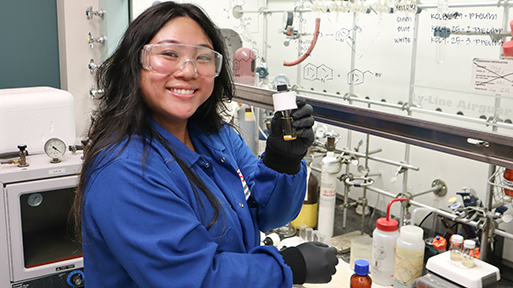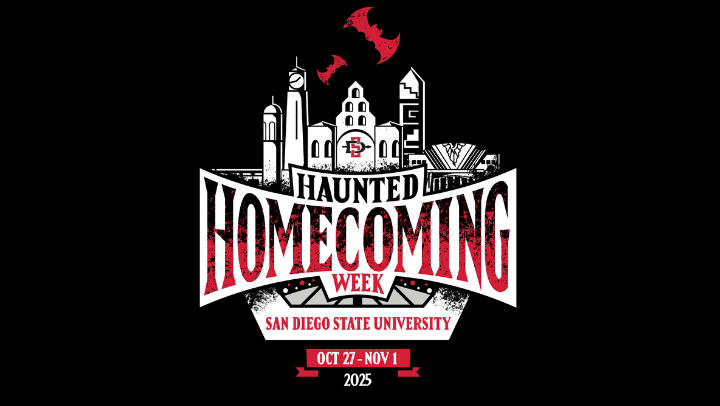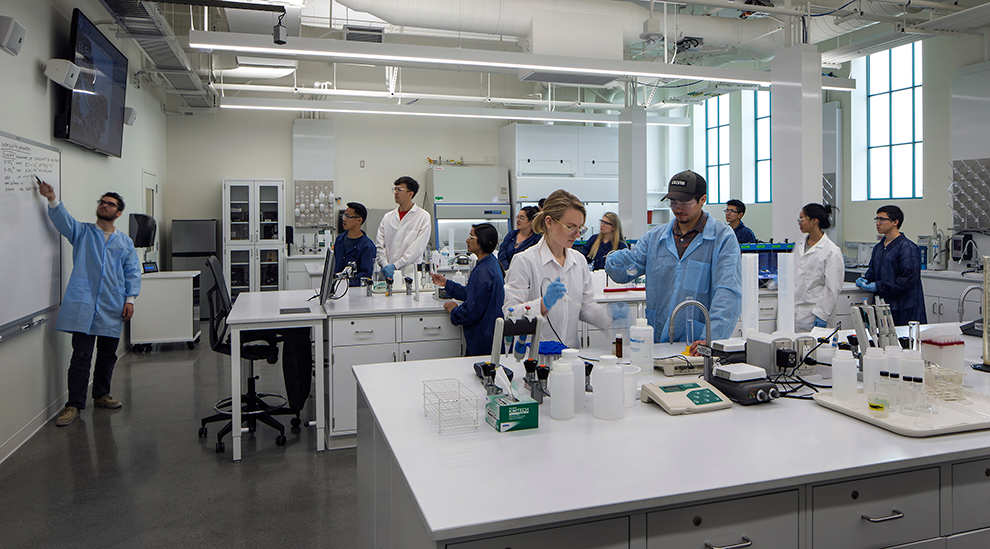Innovators Wanted
The new Engineering and Interdisciplinary Sciences Complex gives students and faculty the skills to bring their ideas to market.

“A lot of engineering students already do go to Zahn with ideas, but with the opportunities presented by the new EIS Complex, we hope there will be even more.”
This story appears in the spring 2018 issue of 360: The Magazine of San Diego State University.
For people with memory disorders, it can be challenging to continually monitor vital signs like body temperature, blood pressure and heart rate. San Diego State University Fowler College of Business student Lucien Aymerick Eloundou had an idea: What if wearable sensors, or sensors placed around the house, could monitor these vital signs independently?
Unknown to Eloundou, SDSU electrical engineering professor Yusuf Ozturk was experimenting with ways to develop mobile devices to ambiently record vital signs in people with Alzheimer’s.
Traditionally, Eloundou’s and Ozturk’s separate academic silos would have kept them from meeting and realizing their shared interests. But thanks in large part to the recently completed Engineering and Interdisciplinary Sciences (EIS) Complex, they’re now working together to turn their shared idea into reality. It’s evidence that SDSU, which has been named by Forbes magazine as one of the country’s top entrepreneurial universities, is equipping students and faculty researchers with the skills to transform brilliant, useful ideas into products that can help people.
“We introduced Lucien to Yusuf and now they’ve been accepted into the second phase of the National Science Foundation’s small business program competition, I-Corps, which makes them eligible for $50,000 in funding,” explained Cathy Pucher, executive director of the Zahn Innovation Platform (ZIP) Launchpad incubator.
Now that the ZIP Launchpad, the Lavin Entrepreneurship Center and H.G. Fenton Company Idea Lab are all under the same roof of the EIS Complex, Pucher expects fortuitous pairings like these to happen even more frequently.
The building, which opened in January, was explicitly designed to foster these “collaborative collisions” by situating entrepreneurship centers and engineering labs in close proximity, banking on the hunch that smart people with smart ideas will naturally bump into one another and find ways to work together. Pucher and others working in the William E. Leonhard Entrepreneurship Center want to do everything they can to help those fortuitous moments happen.
They are planning regular meet-and-greet receptions where student entrepreneurs can mingle with each other, faculty researchers and local industry representatives. Lunch-and-learn sessions will teach students the nuts and bolts of entrepreneurship, like how to file patents or register trademarks. And once the EIS Complex’s coffee shop opens later this year, Pucher suspects the shared love of caffeine will jolt new ideas and fuel innovative partnerships.
“There will of course be incidental ‘collisions,’ but we also want to be intentional about it,” she said. “Having a central location just makes it so much easier for that to happen.”
It doesn’t hurt that the digs themselves just feel conducive to creative thinking. Alex Passenheim, a senior in the Fowler College of Business who has been working with the ZIP program since he was a freshman, always appreciated learning entrepreneurial skills in the program—but said that its former home felt cramped and antiquated.
The first time he saw the new center in the EIS Complex, with its modern design concept and state-of-the-art lab space and technology, he knew the program had taken a big step forward.
“When I walked into this space for the first time, I thought it was like walking into a Google office,” said Passenheim, who is currently working to launch SK8DRY, a company that offers waterproofing products for skateboards. “I’m definitely meeting more potential collaborators here.”
Kyle Kitzmiller, a graduate student studying mechanical engineering at SDSU and former manager of the Idea Lab, said he is seeing more random collisions bear fruit as budding collaborations.
“I’m seeing all of these chance meetings when I’m giving tours of the building or when people are hanging out in the lab,” he said. “I think the chain reactions are going to start happening.”
At a lunchtime meeting of the most recent crop of ZIP Launchpad entrepreneurs, Fowler College of Business students made up about three-quarters of the assembled students munching on pizza and salad. Pucher would like to see a more balanced representation from science and engineering students.
The sheer proximity of the engineering building and the EIS Complex—the two structures share a courtyard and are connected by a bridge—will help that effort, said Morteza “Monte” Mehrabadi, the late dean of SDSU’s College of Engineering. Mehrabadi passed away in March, but he was able to see the EIS Complex’s budding promise for entrepreneurial engineers.
“A lot of engineering students already do go to Zahn with ideas, but with the opportunities presented by the new EIS Complex, we hope there will be even more,” he said.
A number of existing resources that currently link the College of Engineering with the Lavin Entrepreneurship Center should also propel these efforts forward. Several members of the Aztec Mentor Program Engineering Advisory Board also serve as advisers to ZIP Launchpad teams, and those existing relationships can be leveraged to recruit new industry mentors and encourage students to explore the entrepreneurship opportunities within the EIS Complex.



